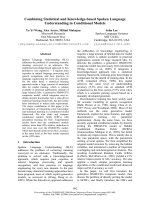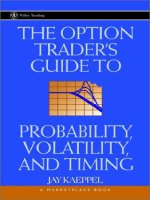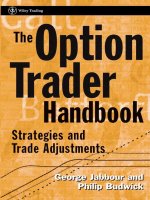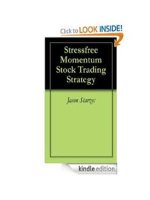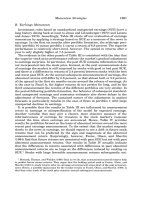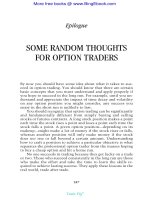Basic option volatility strategies understanding popular pricing models
Bạn đang xem bản rút gọn của tài liệu. Xem và tải ngay bản đầy đủ của tài liệu tại đây (1.76 MB, 96 trang )
Table of Contents
Publisher’s Preface
How to Use this Book
Meet Sheldon Natenberg
Chapter 1: The Most Important Tool for Any Options Trader
Your Goal Is Not to Cut off Your Hand
Black-Scholes: The Grandfather of Pricing Models
The Fundamental Elements of Any Pricing Model
Chapter 2: Probability and Its Role in Valuing Options
Overcoming the Subjective Nature of the Process
The Problem with Probabilities
You Can Agree to Disagree
Expanding the Realm of Probabilities
What Constitutes a Normal Distribution?
How Distribution Assumptions Affect Option Pricing
The Symmetrical Nature of Distribution Curves
Chapter 3: Using Standard Deviation to Assess Levels of Volatility
Standard Deviation
Volatility Numbers Are Fluid
Adjusting Volatility for Differing Time Periods
Examples of a Standard Deviation Conversion
Verifying Volatility
Chapter 4: Making Your Pricing Model More Accurate
Some Essential Adjustments to Your Volatility Input
Key Differences in a Lognormal Distribution
When the Market Disagrees With the Models
Chapter 5: The Four Types of Volatility and How to Evaluate Them
The First Interpretation: Future Volatility
The Second Interpretation: Historical Volatility
The Third Interpretation: Forecast Volatility
The Fourth Interpretation: Implied Volatility
Checking the Inputs: How to Correct Your Valuation
Simplifying the Volatility Assessment
Chapter 6: Volatility Trading Strategies
The Fundamentals of Volatility Trading
Further Adjustments Required
A Black-Scholes Anecdote
The Risks of Volatility Trading
Are You Naked—Or Are You Covered?
A Visual Picture of Volatility
Using Volatility to Improve Your Predictions
A Quick Look at Volatility Cones
The Two Primary Models for Predicting Volatility
Margin Requirements and Commissions
Chapter 7: Theoretical Models vs the Real World
Summary
Appendix A: Option Fundamentals
Appendix B: A Basic Look at Black-Scholes
Appendix C: Calendar Spread: Putting Time on Your Side
Appendix D: Greeks of Option Valuation
Appendix E: Key Terms
Index
Copyright © 2007 by Sheldon Natenberg
Published by John Wiley & Sons, Inc., Hoboken, New Jersey
Published simultaneously in Canada
No part of this publication may be reproduced, stored in a retrieval system, or transmitted in any form
or by any means, electronic, mechanical, photocopying, recording, scanning, or otherwise, except as
permitted under Section 107 or 108 of the 1976 United States Copyright Act, without either the prior
written permission of the Publisher, or authorization through payment of the appropriate per-copy fee
to the Copyright Clearance Center, 222 Rosewood Drive, Danvers, MA 01923, (978) 750-8400, fax
(978) 646-8600, or on the web at www.copyright.com. Requests to the Publisher for permission
should be addressed to the Permissions Department, John Wiley & Sons, Inc., 111 River Street,
Hoboken, NJ 07030, (201) 748-6011, fax (201) 748-6008, or online at
www.wiley.com/go/permissions.
Limit of Liability/Disclaimer of Warranty: While the publisher and author have used their best efforts
in preparing this book, they make no representations or warranties with the respect to the accuracy or
completeness of the contents of this book and specifically disclaim any implied warranties of
merchantability or fitness for a particular purpose. No warranty may be created or extended by sales
representatives or written sales materials. The advice and strategies contained herein may not be
suitable for your situation. You should consult with a professional where appropriate. Neither the
publisher nor the author shall be liable for damages arising herefrom.
For general information about our other products and services, please contact our Customer Care
Department within the United States at (800) 762-2974, outside the United States at (317) 572-3993
or fax (317) 572-4002.
Wiley publishes in a variety of print and electronic formats and by print-on-demand. Some material
included with standard print versions of this book may not be included in e-books or in print-ondemand. If this book refers to media such as a CD or DVD that is not included in the version you
purchased, you may download this material at . For more information
about Wiley products, visit www.wiley.com.
Library of Congress Cataloging-in-Publication Data:
PUBLISHER’S PREFACE
What you have in your hands is more than just a book. A map is simply a picture of a journey, but the
value of this book extends well beyond its pages. The beauty of today’s technology is that when you
own a book like this one, you own a full educational experience. Along with this book’s author and
all of our partners, we are constantly seeking new information on how to apply these techniques to the
real world. The fruit of this labor is what you have in this educational package; usable information for
today’s markets. Watch the video, take the tests, and access the charts—FREE. Use this book with the
online resources to take full advantage of what you have before you.
If you are serious about learning the ins and outs of trading, you’ve probably spent a lot of money
attending lectures and trade shows. After all the travel, effort, expense, and jet lag, you then have to
assimilate a host of often complex theories and strategies. After thinking back on what you heard at
your last lecture, perhaps you find yourself wishing you had the opportunity to ask a question about
some terminology, or dig deeper into a concept.
You’re not alone. Most attendees get bits and pieces out of a long and expensive lineage of lectures,
with critical details hopefully sketched out in pages of scribbled notes. For those gifted with
photographic memories, the visual lecture may be fine; but for most of us, the combination of the
written word and a visual demonstration that can be accessed at will is the golden ticket to the
mastery of any subject.
Marketplace Books wants to give you that golden ticket. For over 15 years, our ultimate goal has
been to present traders with the most straightforward, practical information they can use for success
in the marketplace.
Let’s face it, mastering trading takes time and dedication. Learning to read charts, pick out
indicators, and recognize patterns is just the beginning. The truth is, the depth of your skills and your
comprehension of this profession will determine the outcome of your financial future in the
marketplace.
This interactive educational package is specifically designed to give you the edge you need to
master this particular strategy and, ultimately, to create the financial future you desire.
To discover more profitable strategies and tools presented in this series, visit
www.traderslibrary.com/TLEcorner.
As always, we wish you the greatest success.
President and Owner
Marketplace Books
HOW TO USE THIS BOOK
The material presented in this guide book and online video presentation will teach you profitable
trading strategies personally presented by Sheldon Natenberg. The whole, in this case, is truly much
greater than the sum of the parts. You will reap the most benefit from this multimedia learning
experience if you do the following.
Watch the Online Video
The online video at www.traderslibary.com/TLEcorner brings you right into Natenberg’s
session, which has helped traders all over the world apply his powerful information to their
portfolios. Accessing the video is easy; just log on to www.traderslibrary.com/TLEcorner, click
Basic Option Volatility Strategies by Sheldon Natenberg under the video header, and click to watch.
If this is your first time at the Education Corner, you may be asked to create a username and
password. But, it is all free and will be used when you take the self-tests at the end of each chapter.
The great thing about the online video is that you can log on and watch the instructor again and again
to absorb his every concept.
Read the Guide Book
Dig deeper into Natenberg’s tactics and tools as this guide book expands upon Natenberg’s video
session. Self-test questions, a glossary, and key points help ground you in this knowledge for realworld application.
Take the Online Exams
After watching the video and reading the book, test your knowledge with FREE online exams. Track
your exam results and access supplemental materials for this and other guide books at
www.traderslibrary.com/TLEcorner.
Go Make Money
Now that you have identified the concepts and strategies that work best with your trading style, your
personality, and your current portfolio, you know what to do—go make money!
MEET SHELDON NATENBERG
As you will learn later in this book, volatility is the most nebulous factor in determining what the
value, and therefore the price, of an option actually should be—and no one is more adept at assessing
volatility than Sheldon Natenberg.
As Director of Education for Chicago Trading Company and a highly sought-after lecturer at
professional training seminars both here and abroad, Sheldon has helped many of the world’s top
institutional investors, mutual fund managers, and brokerage analysts better understand volatility and
utilize it in valuing and pricing options of all types.
However, his greatest claim to fame came as the result of his authorship of Option Volatility and
Pricing: Advanced Trading Strategies and Techniques (McGraw Hill, 1994)—considered by many
to be the finest book ever written on the subject. First published in 1988 (revised in 1994), the book
established Sheldon as one of the world’s most acclaimed authorities on volatility and its impact on
option pricing and trading strategies—a reputation he has continued to build ever since. His ongoing
success at evaluating and applying option trading strategies ultimately earned him induction into the
Traders’ Library Trader’s Hall of Fame.
What Sheldon Is Preparing to Tell You
So, why do you need Sheldon’s expertise? Quite simply, because volatility has become a dominant
factor in today’s world—not only in the investment markets, but also in everyday life. Though this
book may not enable you to understand fully the growing political, economic, and social turbulence
that roils daily life, it will help you understand—and potentially profit from—the extreme volatility
apparent in the financial arena over the past two decades.
In the pages that follow, Sheldon will explain the theoretical basis of volatility systematically,
showing you how to calculate volatility levels in various markets, how volatility affects the price
movements of different investment instruments, and how you can profit from those price movements.
He will talk about the four different categories of volatility, the differences between them, and the
types that play the most important role in the leading theoretical pricing models. He will also fully
describe the most popular option pricing models in use today and discuss their advantages, as well as
some problems you may encounter when using them.
Specifically, he will detail the critical impact that volatility has in establishing values and prices
for exchange-traded options and reveal the most common strategies for capturing the discrepancies
that develop when option prices and values get out of line.
In addition, he will do it all with a minimum of mathematical equations and technical jargon.
In short, whether you’ve been an active trader for years or are just now considering whether to buy
your first put or call, the advice Sheldon provides will prove invaluable in integrating options into
your personal arsenal of investment strategies.
Chapter 1
THE MOST IMPORTANT TOOL FOR ANY
OPTIONS TRADER
This book focuses on options, explaining how volatility affects the valuation and pricing of options,
and how you can use this information to refine your option trading strategies and improve your trading
results.
Depending on your situation, this book is a bit unusual for me because I’m used to dealing almost
solely with professional traders—traders for market-making firms, financial institutions, floor
traders, computer traders, and so forth. I know that you may not be a professional trader. However,
lest that concern you, I’d like to assure you of one thing:
The principles of option evaluation are essentially the same for everyone.
Second, by way of disclaimer, I want to clarify something immediately: I am not going to tell you
how to trade.
Everyone has a different background. Everyone has a different goal in the market . . . different
reasons for making specific trades. What I hope you’ll at least be able to do—from the limited amount
of information I’m going to provide—is learn how to make better trading decisions.
However, you’re the one who must decide what decisions you’re going to make.
See Sheldon as he introduces the world of options to you. Log in at
www.traderslibrary.com/TLEcorner to gain exclusive access to his online video.
Your Goal Is Not to Cut off Your Hand
Learning about options is like learning how to use tools—and everyone applies tools in different
ways. For example, if somebody teaches you how to use a saw, your first question becomes, “What
can I do with this saw?”
Well, depending on how well you’ve learned your lesson, either you can make a beautiful piece of
furniture—or you can cut off your hand.
Obviously, those are the two extremes: there are many other uses in between. My point here is that
I’m trying to help you avoid cutting off your hand. You may not learn enough to become a professional
trader, but you will learn enough to avoid disaster, and greatly improve your trading skills.
Maybe that’s not the best analogy, but I think you get the idea.
People often ask me about the types of strategies I use and which are my favorites. I think most
professionals would agree with me: I’ll do anything if the price is right.
The same standard defines my “favorite” strategy, because my favorite is any strategy that works—
and, if the price is right, a strategy usually works.
So, how do I determine whether the price is right?
I determine if the price is right the way almost everybody does: I use some type of theoretical
pricing model—some type of mathematical model that helps me determine what I think the price ought
to be.
Then, whatever strategy I choose to use depends on whether the actual prices available in the
market deviate from what I think they ought to be, or whether they’re consistent with what I think they
ought to be.
So, the primary tool for any professional option trader is a theoretical pricing model—and, if
you’re going to succeed with your own trades, such a model will become your primary tool as well.
With that in mind, let’s talk about a typical theoretical pricing model.
Black-Scholes: The Grandfather of Pricing
Models
By far, the most common option-pricing tool used today is the Black-Scholes model (See Appendix B
for details). Of course, there are other models that are also widely used, but the Black-Scholes model
is most famous because it was the first really widely used pricing model. It was also a theoretical
innovation—so much so that Myron Scholes and Robert Merton, who helped develop the model,
received the Nobel Prize in Economics for its development.
So, if Merton shared in the prize, why is it called the Black-Scholes model?
Well, as a quick aside, this is a perfect illustration of the fact that life is not fair. The Nobel Prize is
given posthumously only if you die within six months of the awarding of the honor. Fischer Black did
much of the theoretical work in developing the Black-Scholes model—but because he died roughly
eight months before the honors were announced, he missed the Nobel Prize.
Of course, his name lives on in the title of the model—and everyone who knows the story
acknowledges that Black really shared the Nobel Prize with Scholes and Merton.
The Fundamental Elements of Any Pricing
Model
Whether you use Black-Scholes or some other pricing model, there are certain inputs that have to be
plugged into the formula. Only after you enter all of these inputs into the model you’re using can you
come up with a theoretical value for an option. So, let’s take a look at the required inputs (Figure 1).
FIGURE 1
Most pricing models, including Black-Scholes, require five—or, in some cases involving stocks,
six—inputs. If you’ve done any analytical work with options at all, you’re likely familiar with the
first four of these inputs:
The exercise price
Time to expiration
The price of the underlying security
The current interest rate
That’s because these are things you can generally observe in the marketplace, as is dividend
information, which is the added input stock traders are required to factor into the model. You may not
know exactly what the correct interest rate is, or exactly what the underlying stock or futures price is,
but you can make a pretty good guess. Likewise, if you’re doing stock options, it’s pretty easy to come
up with the dividend. Obviously, if you’re trading index options or options on futures, there is no
dividend.
The big problem with almost every model, including Black-Scholes, is volatility.
It’s the one input that you can’t directly observe in the marketplace. Of course, there are sources of
volatility data that might enable us to guess what the right volatility input is. However, we never
really know exactly whether we’re correct—and that’s the big, big headache for all traders who use a
theoretical pricing model.
Not only is it extremely difficult to determine the volatility, but traders learn very quickly that, if
you raise or lower the volatility just a little, it can have a tremendous impact on the value of the
option. What happens?
Either the option’s value explodes, or it collapses.
Obviously, whether you’re a professional trader devising hedging strategies for a mutual fund or an
individual investor selecting options for a covered-writing program in your personal account, a lot
will ride on your ability to determine a correct volatility input for the theoretical pricing model. You
simply can’t afford—in terms of either money or long-term trading success—to be at the mercy of
such errors in valuation.
That’s why I focus the bulk of my discussion on just what this volatility input is—what it means,
how it’s used, how you interpret it, and so forth.
----------
Self-test questions
1. Sheldon Natenberg’s favorite options strategy is the one where the price is right. How do
you determine whether the price is right?
a. By buying in the money calls
b. By using the right tools
c. By using a theoretical pricing model
d. By hedging all your trades
2. What is the most common option pricing tool used today?
a. The theoretical pricing model
b. The Black-Scholes Model
c. The Myron-Merton Pricing Model
d. The Binomial Model
3. Which of the following statements about Black-Scholes is incorrect?
a. You should never have to calculate a Black-Scholes option value yourself
b. There are no transaction costs
c. Trading of the asset is continuous
d. It uses an American-style option and can be exercised at any time up to expiration
4. What is the biggest problem, and the one unknown factor, when using pricing models?
a. Exercise price
b. Time to expiration
c. Volatility
d. Interest rate
For answers, go to www.traderslibrary.com/TLEcorner
----------
Chapter 2
PROBABILITY AND ITS ROLE IN VALUING
OPTIONS
To understand volatility and why it’s so important in calculating option values, you have to
understand a little bit more about how theoretical pricing models work. This doesn’t mean I’m going
to launch into a lengthy discussion of option theory, nor am I going to present some complex
differential equation and walk you through it step by step like I might if this were a university
classroom.
What I am going to do is discuss, in general terms, the logic underlying the theoretical pricing
models, and use some basic examples to illustrate how they work. As we go through this process, I
think you’ll find that all of the models are actually fairly easy to understand in terms of the reasoning
that goes into them.
For starters, Black-Scholes and all the other theoretical models that we use in determining option
values are probability based. What exactly does that mean? Well, consider this:
Assume you went out and bought a stock, or you bought a futures contract. Why did you buy that
particular stock? That particular futures contract? Obviously, you bought it because you thought it was
going up. Were you sure it was going up? Of course not! Unless you have access to some kind of
insider information, you can never be sure. All you can ever say is that the stock or futures contract
will be more likely to go up than go down.
In essence, then, all trading decisions are based on the laws of probability.
Overcoming the Subjective Nature of the
Process
The problem with saying that a stock is more likely to go up than down is that this is a very subjective
judgment—and the theoretical pricing models don’t like subjective inputs. The models say we need to
assign actual numbers—specific numerical probabilities—to the possibility of the stock going up or
to the possibility of the stock going down. So, how do you derive these specific numerical
probabilities?
To illustrate, I’ve created a very simple situation. Assume there is an underlying stock or
commodity that’s trading at a price of 100. Then let’s say that, at some future date—which we’ll call
“expiration”—this security could take on one of five prices, ranging from 90 to 110. I’m also
assigning probability to each of those five outcomes—10 percent, 20 percent, 40 percent; then 20 and
10 again—as shown on the scale in Figure 2.
FIGURE 2
Obviously, this example is overly simplified, but it’s best to start from a very simple point for the
sake of clarity.
Now, suppose I go into the market and buy the underlying contract, the underlying security. If I were
to ignore transaction costs, interest rate considerations, slippage—all the other real-world things we
have to deal with—could I actually calculate what I might expect to get back on this contract?
The answer is yes—at least as it relates to calculating all of the likely possibilities.
Here’s how it would work in this particular case. Ten percent of the time, the price of contract at
expiration will come up 90. Twenty percent of the time, it’ll come up 95; 40 percent of the time, it
will come up 100; and so on, up to 110, where it will once again wind up 10 percent of the time. In
other words, what we’re doing is taking the probability that the contract will wind up at each of the
five possible closing prices, and then totaling these probabilities. When we do that, you see that the
total turns out to be 100. See Figure 3.
FIGURE 3
To see Sheldon as he describes this example in detail, watch now at
www.traderslibrary.com/TLEcorner.
What this means is that, if the underlying contract is trading at 100 and you go in and buy that
contract—or sell the contract, for that matter—the probability is that you’re not going to make any
money. Of course, you’re not going to lose any money either—except in the form of transaction costs.
So, as professional traders, what we would say is that this contract or security is arbitrage-free—
that there’s no money to be made in the underlying market. At least that’s what a theoretician would
say.
However, it’s a different story with options. Suppose that, instead of buying the underlying security,
I run out and buy a 100 call. How much would I expect to get back at expiration?
Forget about the price I’m paying for the call. For the moment, I’m not interested in that—or in the
potential profit or loss. Right now, I just want to know what the call is likely to be worth at
expiration. How do we calculate the probabilities on that? We do it in the same fashion as we did
with the underlying contract—though there are some major differences.
We’ve already seen that the result would be a break-even with the underlying contract. But what
happens with a 100 call if the underlying contract is priced at 90, 95, or 100 at expiration? What’s
that 100 call worth? Zero!
European vs. American Options
Most of the examples in this book refer either to the current market price of options or to
their expected value at expiration. That’s because Black-Scholes and the other leading
theoretical option-pricing models all assume that we’re dealing with European-style
options. The term “European” is a distinction given to certain types of options based on
the point in time at which the “right to exercise” is granted. Most options traded in
Europe can be exercised—that is, exchanged for the underlying security—only on the
specified expiration date. By contrast, virtually all options traded in North America (with
the exception of options on stock index futures, some currency options, and a few options
linked to actual physical commodities) can be exercised at any time up to and including
the stated expiration date.
Options in the former class are thus referred to as “European” options, whereas those in
the latter class are called “American” options. Always remember this distinction when
using theoretical option pricing models to value exchange-traded options on U.S. stocks
and futures contracts.
You see, an option has a nonsymmetrical payoff diagram. If the underlying contract is at 100 or
below at expiration, the 100 call will always be worthless. But, if the underlying contract is at 105,
the 100 call will be worth 5 points. Assuming the same probabilities you saw in Figure 2, that’s going
to happen 20 percent of the time. Likewise, if the underlying contract is at 110, the 100 call will be
worth 10, which will happen 10 percent of the time (Figure 4).
FIGURE 4
If I then add up these partial probabilities, I come out with a theoretical value for the 100 call of
2.00 points. In other words, the laws of probability say that, if I pay 2.00 points for the 100 call
today, the likelihood is that I will break even on the option at expiration.
Thus, defined in simplest terms, the theoretical value of an option is what the laws of probability
say will happen in the end.
Of course, there are some lesser considerations that also have to be taken into account with most of
the pricing models—for example, interest rates. In this instance, if the expected return was 2.00
points and the current interest rate was 12 percent, you would have to discount the expected return by
the cost of money—determining what is sometimes called the present value of 2.00 points. In this
case, the interest-rate adjustment would give us a revised theoretical value of 1.96 points (See Figure
5).
FIGURE 5
In addition, there can be a substantial difference between the theoretical value and the actual market
price. That’s because, if I were an options market trader, I’d always try to bid at less than the
theoretical value and offer at more than the theoretical value.
In other words, if I were a trader, somebody might come to me and ask, “Shelly, what’s your market
in the 100 call?” Even though the theoretical value of the call was 2.00, I would say, “I’m 1.90 at
2.10,” or, “I’m 1.80 at 2.20”—whatever spread I thought I could get away with, depending on the
competition in the marketplace.
If I trade using spreads such as those, does it guarantee that I’m going to make money? No, of course
not. It just says that, if I do it enough times, in the long run, I should profit by the difference between
my trade price and the theoretical value.
The Problem with Probabilities
So, the first step in understanding any theoretical model is to understand that all the models are based
on probabilities.
The big problem comes in determining accurate probabilities.
All of the theoretical models—and, once again, they all work in essentially the same way—require
that you propose a series of potential ending prices for the underlying security. That’s what I did in
the previous example when I set prices ranging from 90 to 110. The models then require that you try
to assign a probability to each of those potential ending prices—which is what I did when I said there
was a 10 percent chance the price would end up at 90, 20 percent at 95, and so on. Finally, by
calculating an expected return based on those probabilities, the models come up with a theoretical
value for the option.
As already noted, there are lots of different theoretical pricing models. You’ve got the BlackScholes model. You’ve got a binomial model. You’ve got a wavy model. You’ve got some other,
more exotic models. However, they all use essentially the same reasoning. The big difference is in
how the various models assign the probabilities.
Some of the models use historical trading patterns to assign the probabilities, some use
mathematical formulas, and others use different mathematics. But all the models have one very
important characteristic in common: they all assign probabilities in such a way that, if you were to
trade the underlying contract, you would always break even.
In other words, each of the recognized models assumes that the underlying market is arbitrage-free.
Watch Sheldon explain the theoretical pricing models at
www.traderslibrary.com/TLEcorner.
You Can Agree to Disagree
You do not need to agree with any of the assumptions in the theoretical pricing model. However, to
be an intelligent trader—to use options intelligently—you must understand what those assumptions
are.
I just said that the models all assume the underlying market is arbitrage-free—which begs a
question. Have you ever bought or sold a stock or a futures contract? Sure, you have. Almost
everyone has at one time or another. Well, in so doing, you’ve just violated the key assumption in the
theoretical pricing model. Why? Because the model says you can’t make money. In an “arbitragefree” market, you’re supposed to break even.
Of course, people who buy and sell stocks and futures contracts know that they can make money. If
you’re good at using technical analysis, fundamental analysis, market timing, or whatever, you can
make money buying and selling the underlying contracts. You know it, and I know it. It just doesn’t
happen to be a part of the theoretical world on which these models are based.
Thus, to some extent, every trader disagrees with the model. Everybody knows the model is not a
perfect representation of the real world. But we all use the theoretical pricing models anyway—
except we fudge. We change them around; we use them in a way that we think makes us better traders,
or that makes our trading more consistent with the real world.
That’s essentially the basis of all the theoretical pricing models.
Expanding the Realm of Probabilities
However, there’s still one big problem in addition to the probabilities assigned to the prices shown
for the underlying contract. The problem is that I’ve only proposed five potential ending prices for
that contract (see the scale in Figure 6).
FIGURE 6
In the real world, how many possible prices are there for any underlying contract? That’s right, an
infinite number. You know, one cent, two cents, one million, two million . . . Just take your pick
(Figure 7).
FIGURE 7
So, if I wanted to develop a really good theoretical pricing model, I’d have to consider an infinite
number of potential prices, and I’d have to propose probabilities for every one of those prices.
Now, how can you deal with an infinite number of anything? Obviously, it’s very difficult . . . sort
of like trying to count the stars in the sky. But most theoretical pricing models—traditional theoretical
pricing models—have made the assumption that the world of trading looks like a normal distribution.
It’s the well-known bell-shaped distribution where most of the probability is located in the middle
and, as you get further and further away from the middle, you have steadily declining probabilities
(Figure 8).
FIGURE 8
FIGURE 8
This is reasonably consistent with our intuition about the market. If I tell you some underlying
contract is trading at 100 today, and I then tell you that, a week from now it can trade at either 101 or
1,000, which is more likely? Well, most people would say 101. Why? Because we know that, as you
move further away from the current price, the probability of reaching some extreme price becomes
less and less likely.
What Constitutes a Normal Distribution?
Black and Scholes were the first to make this assumption—that prices would follow a normal
distribution. And, why did they make this assumption? They got the idea based on some studies that
had been done on markets, dating back to the early 1900s—studies actually conducted by a French
economist. The economist had reviewed the performance of some French stocks and stock indexes
and came to the conclusion that, if you looked at stocks and stock indexes over a fairly long period of
time, the prices did seem to be normally distributed. They did seem to form this bell-shaped curve.
Now, is this a perfect assumption? Of course not. Nobody in his or her right mind would ever say
that this is a perfect assumption.
But then, Black and Scholes weren’t aiming for perfection. They were trying to come up with a
generalized pricing model—one that sort of fit every market, but didn’t exactly fit any market.
So, this is the most basic assumption that’s built into Black-Scholes and many similar theoretical
pricing models—that prices are normally distributed. The big problem for the professional or
individual trader then is to determine if the market (or security) that he or she is trading really fits a
normal distribution.
Earlier, I assured you I wouldn’t throw up a bunch of differential equations or complicated
mathematical formulas, and I also want to promise that this isn’t going to turn into a course in
statistics. However, to understand any talk about volatility, you simply must know a little bit more
about the characteristics of this normal-distribution pattern—this bell-shaped curve.
For starters, all normal distributions are defined by two numbers—the mean and the standard
deviation (Figure 9).
FIGURE 9
The mean is a measure of where the peak of the distribution curve occurs. For most purposes—just
to simplify things—we assume the mean is the current price of the underlying contract.
I admit I’m fudging just a bit here on some of the theory because I don’t want to make this too
complex, but that definition is sufficiently accurate for most purposes.
The standard deviation is a measure of how fast the curve spreads out. Curves that have a high
standard deviation spread out in a big hurry. In other words, they’re very wide. Curves that have a
low standard deviation don’t spread out much at all; they’re very narrow.
Thus, it’s possible to have a number of different “normal” distributions, based on the differing
means and standard deviations. Once you know the specific mean and standard deviation, the other
characteristics of all normal distributions are essentially the same. Look in any statistics textbook and
it will list all the characteristics of a normal distribution.
So, the mean and the standard deviation are the two numbers traders have to deal with when they’re
talking about volatility. We’ll see precisely how they apply to volatility in a bit, but first let’s see
what the assumption of differing normal distributions might mean in terms of very simple option
pricing.
How Distribution Assumptions Affect Option
Pricing
Let’s again assume that there is an underlying contract trading at 100. Now, suppose I’m interested in
trading a 120 call. What is this 120 call worth? Well, the call’s worth depends on, among other
things, which distribution I think applies to this particular market.
Suppose there are 90 days until expiration and the value of the option depends on the likelihood of
the option going into the money. In other words, it depends on how much of the assumed price
distribution curve for the underlying contract is above the exercise price—or, thinking in visual terms
(see Figure 10), to the right of the exercise price.
FIGURE 10
Why above or to the right of the exercise price? Because, if the price of the underlying contract is
below or to the left of the exercise price, it means the call option is worth zero. At any contract price
below the call’s exercise price, the call is worthless.
That’s one of the nice characteristics of an option—it can never be worth less than zero, no matter
how far out of the money it is. Of course, what it’s actually worth will depend on how much the price
of the underlying contract goes above (or to the right of) the option’s exercise price—that is, how
much the call goes into the money.
In-, At-, or Out-of-the-Money
The most important component of an option’s price, or premium—both before and at
expiration—is the position of its strike price relative to the actual price of the underlying
stock, index, or futures contract. All options are in-the-money or out-of-the-money at any
given time—except for the rare occasion when the price of the underlying contract is
exactly the same as the option’s strike price. And, because many trading strategies call
for buying or selling in-the-money or out-of-the-money options—or both—it is important
to know which is which. By definition, an in-the-money option is one that has real—or
intrinsic—value, whereas an out-of-the-money option is one that has only time value.
There is, however, an easier way to make the distinction:
CALLS with strike prices below the actual price of the underlying security are in-themoney.
CALLS with strike prices above the actual price of the underlying security are out-of-themoney.
PUTS with strike prices above the actual price of the underlying security are in-themoney.
PUTS with strike prices below the actual price of the underlying security are out-of-themoney.
In addition, the put or call with the strike price closest to the actual stock price—whether
slightly in-the-money or slightly out-of-the-money—is traditionally referred to as being
at-the-money.
Now then, suppose I tell you that the contract underlying this call option goes up or down, on
average, 25 cents every day. How likely is it that the 120 call will go into the money?
Well, without even talking about normal distributions, you probably would say: “Gee, if it goes up
or down 25 cents every day, in order to get to 120, it would have to go up 80 days in a row, because
25 cents is a quarter of a point and it would have to move 20 points.”
How likely do you think that is? It’s almost impossible. It would be like flipping a coin 80 times
and getting heads every time.
Of course, from a normal distribution point of view, we might draw the distribution curve that goes
with this. Then we can easily see that there’s almost no chance this 120 call option will go into the
money. So, given those circumstances, what’s it worth now? We might give it a 5-cent value, but it’s
probably worth much less than that (Figure 11).
FIGURE 11
Now suppose I tell you that this market—this particular underlying contract—typically goes up or
down by $2.00 every day. How likely is it that our 120 call option will go into the money by
expiration? It’s still not very likely because the market would have to go up by $2.00 a day for 10
days in a row before the underlying contract’s price would get to 120.
If you draw the normal distribution curve that goes with this amount of daily movement, you’ll
quickly see that—even though it’s not very likely—there is still some chance the 120 call option
could go into the money. Not a lot—but a lot more than with the 25-cent-a-day scenario (Figure 12).
FIGURE 12
A mathematician would calculate the value of this potential movement of the call option into the
money, integrate the probability into a pricing formula, and then determine a current value for the 120
call. I’m not a mathematician, but I did do some quick numbers and, in this case, came up with a value
of around 75 cents.
Now let’s take the most extreme case imaginable for this call option: the underlying contract moves
up or down by $10 every day—maybe it’s a tech stock.
Given that, how likely is it that the 120 call could go into the money? There’s a pretty good chance.
That’s particularly evident if you again draw a distribution curve associated with price moves of that
size. The curve is much flatter and wider than in the other two cases—and a substantial portion of the
curve extends to the right of the option strike price. This means that there’s a good probability that the
price of the underlying contract could move above the 120 strike (as represented by the black area in
Figure 13). Based on that, a value of $8.00 for the option is reasonable.
FIGURE 13
So, even though in theory I might make the assumption that the market for this particular underlying
security looks like a normal distribution, I still have to figure out which distribution applies before I
can accurately value the call. That is obvious because, in the first case, the option was valued at 5
cents. In an alternate case, it was worth 75 cents, and in still another case it was worth 8 dollars. And
you don’t have to be a mathematician to know that there’s a really big difference between 5 cents and
8 dollars.
The Symmetrical Nature of Distribution
Curves
Review Figure 13 again. You’ll notice that all three normal distributions are symmetrical. The curve
to the right of the mean, or current-price line, is the mirror image of the curve to the left of the mean,
or price line. In other words, the distribution looks the same moving from left to right as from right to
left.
What’s the significance of that in terms of option pricing?
Suppose I take an 80 put option on the same underlying security. Under what market conditions is
the 80 put worth the most? It turns out the 80 put is worth the most under the same market conditions
that make the 120 call worth the most (Figure 14).
FIGURE 14
That’s because markets that are moving very, very quickly cause all option values to go up. The
basic assumption that results from any normal distribution is that market movement is random—that
you can’t predict in which direction the market is going. In other words, you could say that there’s
always a 50 percent chance the market will go up and a 50 percent chance the market will go down.
Quite often, that turns out to be a really big surprise to new options traders, who frequently start out
with the idea that what affects an option price most is the direction of the market. Of course, we
quickly learn that that’s not what has the greatest effect on an option’s price. What has the greatest
effect on the option is the perception in the marketplace about how fast the market is going to move.
So, if you get markets that are moving very, very quickly, then all options are going to go up in
value. It doesn’t matter whether they’re puts or calls; whether they have higher exercise prices or
lower exercise prices.
In the same way, if we were in a market that was moving very slowly, what would happen to all
option values? They’d start to collapse—and, once again, it wouldn’t matter whether they were calls
